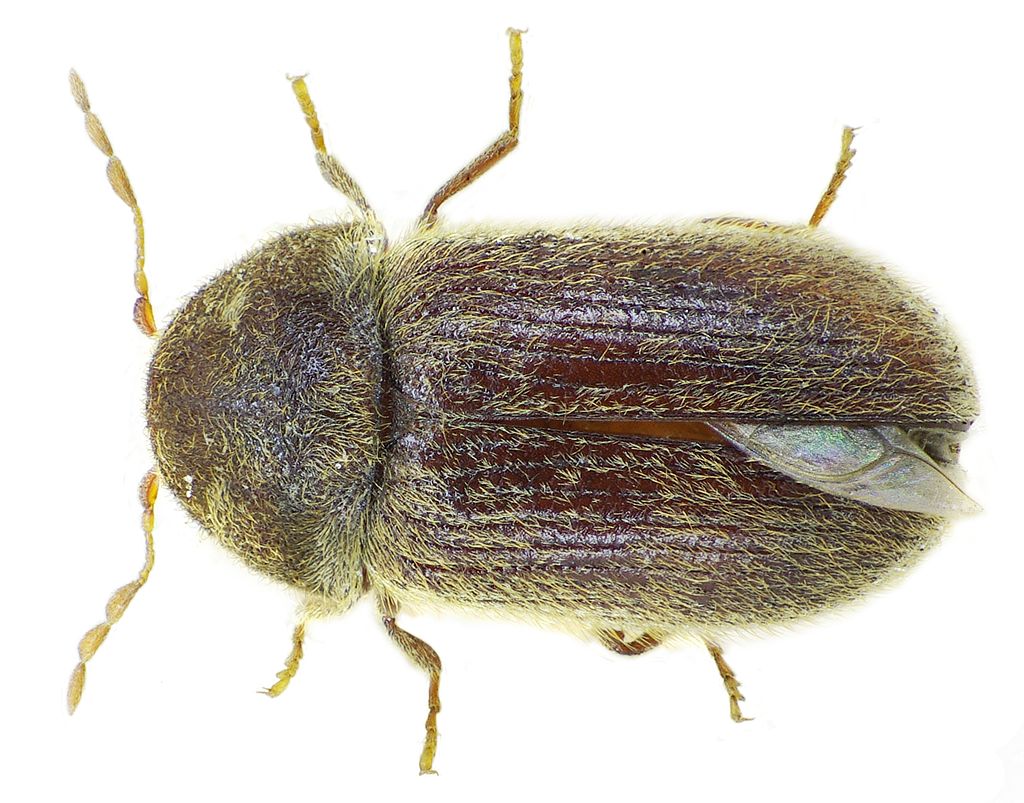SERVICE REQUEST?
Fill out the form below.
Find our nearest location
Your Local Office

Drugstore Beetle
Attribution: Siga, [GFDL or CC-BY-SA-3.0-2.5-2.0-1.0], via Wikimedia Commons
Size:
1/10 to 1/8 of an inch
Color:
Reddish brown to dark brown
Behavior:
The female drugstore beetle lays up to 75 eggs in her lifetime and may deposit them on more than one food source. Under ideal conditions (85° F and 60-90% relative humidity) the life cycle from egg to adult can take as little as five months. Seven months is more common, however. Varying temperatures and humidity play a significant role in speeding and slowing development of larvae within infested foods. In most cases, the drugstore beetle can complete as many as four generations per year in warm climates or inside warm buildings. The larvae are external feeders and are capable of damaging whole grains or seeds. Adults actively crawl and fly.
The drugstore beetle’s Latin name of paniceum was derived from its habit of feeding on bread. Its common name was given because it can be found infesting drugs and similar products. This beetle, however, will literally feed on any dried, food-based material, especially dried pet foods, cereal products and spices. It has also been observed to damage books by feeding on the bindings. The drugstore beetle can be found worldwide, but is more common in regions with warmer climates or in heated structures in temperate climates.
The control of any stored product pest involves many steps, primary of which is discovery of infested food items or other sources of infestation (e.g., food spillage accumulation). All dried food products need to be inspected for signs of infestation, including cereals, packaged dried foods (e.g., food bars and chocolate) and pet foods. Drugstore beetles have also been found infesting spices, potpourri and decorations made of vegetative materials. Keep in mind that infested items may not always be stored in the kitchen. Spices, potpourri and decorations made of vegetative products may be stored in any room of a house. Infestations have also been traced to caches of nuts and seeds accumulated by squirrels or rodents within attics, walls and chimneys. A pest management professional can be helpful in finding difficult infestation sources. Also consider the following to prevent an infestation: · Discard infested foods in outdoor trash. Infested decorations (flowers, wreaths, etc.) should also be discarded. · Freeze suspect foods at zero degrees Fahrenheit for six days. · Clean cabinets and shelves where infested foods are stored by vacuuming and by using soap and water. · Store all dried food goods, including dried pet foods and birdseed, in a glass or plastic container with a tight lid. If beetles are in that food product then the infestation will be contained and not spread to other foods. · Consider storing cereals and similar foods in the refrigerator to limit stored product pest problems. · Consume older food products prior to newer purchases of the same food. Products purchased in larger quantities (e.g., from a wholesale food warehouse) are more likely to become an infestation source if these are stored for long periods of time – especially if they are not stored in containers with tight-fitting lids.
Family Name:
Stegobium paniceum
Read What Our Clients
Are Saying
My Terminix tech Scott is the best! He is professional, courteous and absolutely thorough about his job. Thank you for sending such a blessed tech to my house. Hamlet, NC
This letter is to say how pleased we are here at Morreene West Apartments with your services. We are very pleased with the technician, Christopher. He does a great job. Durham, NC
Terminix has consistently offered our apartment complex reliable, competent service. We are completely satisfied with their knowledgeable representative who is always punctual and does a superior job for us every time. Chapel Hill, NC
I would like to take the time to thank you for giving us such great service here at Carver Pond Apartments. Your Pest Technician Christopher Mitchell has provided us with excellent service over the last few months. Christopher is such a great help to us in providing helpful information so that we can better serve our residents here at Carver Pond. Durham, NC
SERVICE REQUEST?
Fill out the form below.